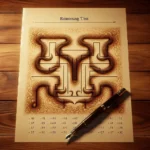The Horn Art Reasoning Test: A Cognitive Evaluation of Artistic Thinking
Assessing an individual’s reasoning skills has always been a significant challenge in the field of psychological and cognitive evaluation. Over time, various tests have been developed to probe different dimensions of intelligence and problem-solving abilities. Among these evaluative tools, one that stands out for its unique approach is the Horn Art Reasoning Test. This test has been specifically designed to evaluate an individual’s artistic thinking and reasoning abilities, providing a platform for educators, psychologists, and artistic professionals to understand the cognitive processes behind creative endeavors.
The Horn Art Reasoning Test gets its name from the cognitive psychologist John L. Horn, a proponent of the theory of multiple intelligences and the idea that reasoning is multifaceted. Horn emphasized that traditional intelligence tests often fail to encapsulate the breadth of human cognitive abilities, particularly in the area of creativity and artistic expression. This test seeks to fill that gap by offering a specialized evaluation of reasoning skills within the context of visual arts.
What the Horn Art Reasoning Test Measures
The test measures several key cognitive elements related to artistic reasoning, such as:
1. Spatial intelligence: The ability to perceive the visual world accurately, modify perceptions, and recreate aspects of one’s visual experience even in the absence of the relevant stimuli.
2. Creative problem-solving: The ability to apply unconventional methods to generate original and valuable solutions to problems.
3. Aesthetic appreciation: The understanding and appreciation of beauty in art forms, as well as the capacity to make nuanced judgments about art.
4. Conceptual expansion: The ability to transcend traditional ideas and create new concepts that are not limited by existing boundaries or norms.
These components are seen as crucial for individuals who are involved in artistic professions or pursuits, where creative thinking and the ability to visualize abstract concepts are essential.
Structure and Administration of the Horn Art Reasoning Test
The Horn Art Reasoning Test is generally administered in controlled environments, such as educational institutions, creative workshops, or psychological clinics. It is divided into a series of segments, each targeting specific facets of artistic reasoning. These may include:
– Visual puzzles that require the test-taker to use spatial skills to manipulate shapes and forms.
– Pattern recognition tasks that require identifying common themes or trends in different artwork.
– Scenario-based questions that challenge the test-takers to solve artistic dilemmas or to propose creative expansions on existing artwork.
– Questions that examine the individual’s knowledge and interpretation of art theory, history, and movements.
The format of the test is designed to be engaging and stimulating, encouraging test-takers to approach each question creatively while applying their cognitive skills to arrive at a solution.
Interpreting the Results
The results of the Horn Art Reasoning Test offer a detailed insight into an individual’s strengths and potential areas for improvement in artistic reasoning. High scores on the test usually indicate a strong ability to think creatively within the visual arts, as well as a high level of spatial intelligence and aesthetic appreciation. Lower scores, on the other hand, may point to areas where an individual could benefit from further education or hands-on artistic experience.
Educational institutions often use these results to tailor their art programs to better serve the needs of their students. In the professional realm, these results can influence recruiting decisions, highlighting candidates with strong innovative thinking skills, which are highly sought after in creative industries.
Relevance in Today’s Artistic Landscape
In our visually saturated culture, artistic thinking and reasoning are not limited to the confines of traditional art forms. Today’s digital world calls for an ever-increasing level of creativity in various fields, such as graphic design, advertising, multimedia art, and user interface design. The Horn Art Reasoning Test provides a means to identify and nurture individuals who possess the cognitive skills to succeed and innovate in these fast-paced and dynamic environments.
Additionally, as more sectors recognize the value of creativity and design thinking in problem-solving and product development, artistic reasoning has become an asset across disciplines. The test’s focus on spatial intelligence and conceptual expansion makes it applicable to architecture, engineering, and even technological fields, where visualization is key to exploring new frontiers.
In educational settings, the Horn Art Reasoning Test serves as a vital tool to foster an environment where students of art and design can grow and refine their talent. By identifying specific cognitive strengths and weaknesses, educators can construct curriculums that address gaps in knowledge and ability, therefore enabling a more comprehensive development of their students’ artistic capabilities.
Challenges and Future Directions
While the Horn Art Reasoning Test has been a significant step in recognizing and evaluating creative intelligence, it also faces challenges. One major hurdle is ensuring the test’s adaptability to account for cultural differences in the interpretation and appreciation of art. Artistic expression is deeply influenced by cultural background, and future iterations of the test will need to accommodate this diversity.
Moreover, the emergence of new media and art forms, like virtual and augmented reality, requires ongoing updates to the test to stay relevant. As the ways we create and interact with art evolve, so too must our methods of assessing artistic reasoning. Research and development in the field of cognitive evaluation are crucial to maintaining the test’s effectiveness and reliability.
Conclusion
The Horn Art Reasoning Test is a testament to the complexity and significance of artistic thinking. It provides an in-depth analysis of the cognitive abilities specific to art and design, empowering individuals and organizations to recognize and invest in creative intelligence. As society increasingly values innovation, tests like these will play a pivotal role in identifying and nurturing creative talent. By challenging traditional notions of intelligence and embracing the multifaceted nature of the human mind, the Horn Art Reasoning Test stands as a beacon for those looking to understand and harness the power of artistic reasoning.

